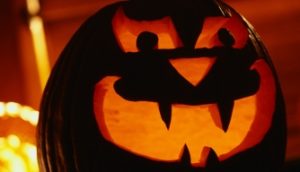Double, Double, Toil & Trouble
Oct. 31 is a day for dressing up and eating candy. Houses across the country carve pumpkins, put up Halloween decorations and head out for the night in costume, but this wasn’t always how this spooky day was celebrated.

Thousands of years ago, it is believed that ancient Celtic people celebrated the festival of Samhain, which took place on Nov. 1. This celebration signified the end of summer and the beginning of winter.
It was believed that the dead returned as ghosts on the eve before Samhain. In order to prevent the ghosts from bothering the living, people would leave food and wine on their doorstep as an offering, according to the History Channel. When people needed to leave their house, they would disguise themselves by wearing masks because they thought it would help them blend in with the ghosts.
Eventually, children and the poor would dress up and ask for food in exchange for prayers for the dead. In the mid-18th century, Pope Gregory III declared Nov. 1 as All Saints’ Day, a day to remember those who have reached heaven. Today, the Halloween holiday has strayed from that of a religious observance.
Trick-Or-Treat
The custom of trick-or-treating is a modern twist on “guising.” This 19th century tradition from Scotland and Ireland involved dressing up and performing in exchange for sweets.

When Irish and Scottish immigrants came to the United States, they brought this tradition with them and it evolved into what we now know as trick-or-treating. The focus of the holiday then began to shift to pranks, such as egging mailboxes and throwing toilet paper in trees. It wasn’t until later in the 1900s when Halloween became the family-friendly holiday that it is today.
Yelling “trick-or-treat!” at neighbors and dressing up in costume aren’t the only Halloween traditions that have a commonly unknown beginning. Before you get to pumpkin carving, you’ll want to know where this tradition began. The origins of the Jack o’ Lantern comes from an Irish legend where the hero held a carved fruit with a fire in it in order to see. Some say this was a turnip to ward away evil spirits.
There are different beliefs about Halloween that come from different regions of the world. Wiccans and Pagans still celebrate Samhain Eve as a day to remember those that are no longer with us.
Little by little this holiday has evolved into what it is today, with homes decorated with pumpkins, ghosts and goblins in preparation for handing out candy to excited children in costume. While Halloween brings together many religions and tradition, it will continue to evolve as the years go on.




Comments